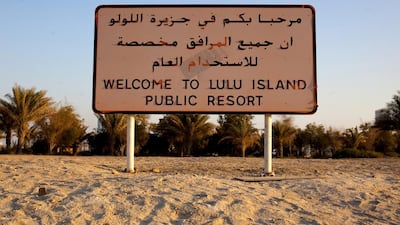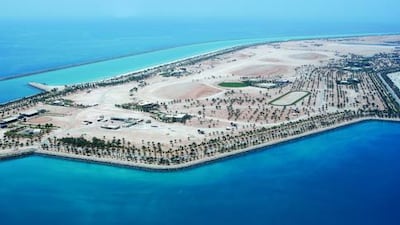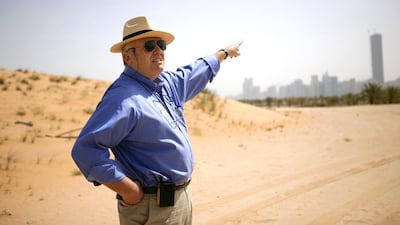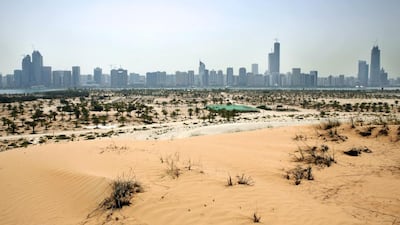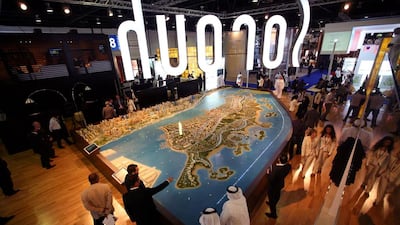A man-made breakwater that shelters Abu Dhabi island from the high tides and open waters of the Arabian Gulf, Lulu Island sits squeezed between the crab-like pincers of its marina and the docks at Mina Zayed.
The result is a rather unlovely blot on the horizon and a 600-metre-wide lagoon that fronts the capital’s carefully manicured Corniche.
Unlike its name, which means “pearl” in Arabic, there is nothing beautiful or romantic about the island’s 500 barren hectares, but that hasn’t prevented Lulu from developing a strangely fascinating and unusual atmosphere.
Instead, Lulu’s peculiar genius loci stems from the fact that in the midst of an urban landscape shaped by relentless and near continuous development, the island displays an inertia that is both uncanny and unique.
While malls and museums, racing circuits and marinas have risen from the sands of nearby islands such as Reem and Al Maryah, Saadiyat and Yas, Lulu appears to have resisted all attempts at development.
If Abu Dhabi island is a palimpsest that retains fragments of its urban past, Lulu Island is a screen on which dreams have been projected, but which have barely left a trace.
And so the island remains empty, scarred only by a handful of abandoned jetties, cabanas, cafes and a deserted camel riding circuit – relics from a time when it was briefly open to the public.
Hassan Mahmood readily admits to being mildly obsessed by what he describes as Lulu’s “lack of progress”.
“It hasn’t changed for as long as I’ve been here,” says the 43-year-old engineer who arrived in Abu Dhabi in 2008 and is now living on a Corniche that has been transformed during the same period, thanks to the construction of megastructures such as Foster + Partners’ World Trade Centre, Etihad Towers and HOK’s new headquarters for Adnoc.
Mahmood finds Lulu difficult to ignore because he looks at the island “almost every day” from the kitchen window of his 14th-storey apartment in Al Markaziyah.
“I suppose it’s ideal if you can get there and you want the beach to yourself,” he explains. “But given all of the other things that have changed in this city, the fact that it’s still empty is a mystery to me.”
That state of suspension has persisted since the early 80s when Lulu was built amidst proposals that immediately identified it as a location for leisure, culture, spectacle and luxury, predating Abu Dhabi’s plans for Saadiyat by more than 25 years.
“In the case of this beautiful and unique island, the important thing, in our view, is to create a comprehensive and unforgettable show” wrote the Brazilian master architect Oscar Niemeyer in 1981.
The designer of some of the most instantly recognisable modernist buildings of the 20th century, Niemeyer worked on a proposal for Lulu even before the island had a name.
Niemeyer’s plans for his “leisure island” included hotels and waterside residences, an elevated monorail, marina and aquarium, a nautical club, helipads, a convention centre and a zoo.
The star attractions, however, were a rejuvenation centre designed to attract geriatric medical tourists, and a culturally sensitive theme park that took its inspiration from One Thousand and One Nights.
Niemeyer considered the complex, which he designed as two enormous domes bisected by a sloping ramp, as a more suitable replacement for the “scheduled Disneyland” that was already under consideration, but which, for the architect, had “nothing to do with the Arab world”.
Thirty-five years after he produced his lyrical sketch scheme, the architect, who produced more than 600 designs during his seven-decade-long career, still expressed regret at its rejection.
“It was a project I worked on with great energy,” the 98-year-old remembered. “But which, unfortunately, did not come off paper.”
Ironically, it is this failure, and the fact that Niemeyer’s scheme sat unpublished and forgotten in an archive for many decades, that makes it a Lulu Island proposal par excellence.
Niemeyer’s quotes, notes and drawings are the subject of a new book, Oscar Niemeyer in Abu Dhabi, which was launched at the Architectural Association in London this week.
The book was written and researched by John Burns of Brownbook, who sees a certain prophetic quality in Niemeyer’s proposed electric vehicles, raised monorail and cultural district.
“Had Niemeyer’s proposal been commissioned,” Burns writes, “Abu Dhabi would have seen Lulu Island become its first epicentre of architecture, culture and leisure”.
But if, as Burns suggests, traces of Niemeyer’s proposal can be still be seen in the Dubai Metro, at Masdar City and on Saadiyat Island, its impact on the subsequent proposals for Lulu was even more profound.
Niemeyer’s emphasis on spectacle and leisure provided the island with a frame of reference that lasted for a generation but by 1997 it looked like the dream of Lulu had finally come to an end.
Faced with spiralling costs which had doubled from earlier estimates, plans for the island’s development were finally brought to a halt.
“The Abu Dhabi government has shelved the project indefinitely because of its high costs and its other commitments,” said an unidentifed Western diplomat who was quoted in an Agence-France Presse report that was reprinted in The Emirates News.
“The Government believes there is no rush for the project as it is a recreational project. There are other pressing needs.”
By September 2003 however, Lulu Island was back on the agenda when the establishment of the General Corporation for Development and Investment of Lulu Island.
Funded by the Abu Dhabi government to the tune of Dh100 million, the purpose of the corporation was to “develop and invest in Lulu Island in Abu Dhabi and turn it into one of the city’s modern hallmarks,” said its royal decree.
The corporation’s plans for the island included a wildlife reserve, “fun parks”, hotels, restaurants, man-made lakes and even a museum, but when Lulu finally opened to the public in 2007 the facilities that had been created, which included two restaurants, four coffee shops, a track for camel and horse riding and two artificial lakes, felt underpowered to say the very least.
By this time however, the thinking around Lulu Island had shifted once again.
In 2006, President HH Sheikh Khalifa bin Zayed Al Nahyan was presented with a new plan for the island by the master developer Sorouh Real Estate, which envisaged Lulu as “a new waterfront bustling with mixed use commercial, residential, cultural and recreational facilities” but architectural hubris appeared to have reached new levels when, four years later, the US architecture giant Skidmore Owings & Merrill presented plans for their 1,312-foot-high Lulu Tower, a 75-storey high-rise that would have been shaped like a giant clam.
The following year Abu Dhabi’s Department of Transport awarded a consultancy contract for the Lulu Road Project, an eight-kilometre-long, six-lane road that would connect the marina on Abu Dhabi’s breakwater with the docks at Mina Zayed.
As always seems to be the way with Lulu Island, none of these projects is yet to come to fruition but what is it about the island that makes it so resistant to development?
In an interview with Brownbook’s John Burns, the former translator and interpreter to Sheikh Zayed bin Sultan Al Nahyan, Zaki Nusseibeh described Lulu Island as a “late starter” but the Lebanese artist Rayyane Tabet has put forward another theory.
“Because I am a believer in poetry, I think there is something beside the social, political or economic reasons that might be behind the lack of execution of any of the projects connected with Lulu Island.”
In 2013 Tabet, who specialises in researching and retelling hidden histories, was commissioned to produce a performance as part of that year’s Abu Dhabi Art.
To unwary visitors looking for a free cruise around Lulu Island, Looking for Pearls seemed like an ordinary boat tour, but as the boat embarked it soon became clear that they were about to experience something quite different.
Looking for Pearls was actually Tabet’s investigation into the stories that had accumulated around Lulu Island’s fantastical past.
“Lulu has always been a place that is as fictional as it is true, as imagined as it is real,” the artist explains.
“There was talk about wild cats that took over the island and even a mermaid, but for me it wasn’t a case of trying to distinguish between the factual and the anecdotal, it was more a case of taking on all of Lulu’s stories equally. It’s what the island calls for.”
For Tabet, who trained as an architect before he became an artist, one of the most fantastical stories he uncovered related to the island’s unusual shape.
“Quite by accident, I read that Lulu had been built in the shape of Abu Dhabi but that it was five times smaller. That’s an extremely interesting and radical idea.”
To test this Tabet made a drawing of the island and then enlarged and rotated it. Whether the story was true or not, the enlarged Lulu Island mapped onto Abu Dhabi island almost perfectly.
“There are these moments when there is suddenly the means to execute an idea that can only exist in the imagination, when an imagined situation gets executed and is given form, but in doing that there is also a moment when the pure poetry removes the possibility of realising anything else,” the artist explains.
“A lot of the projects that have been proposed for this island belong in the realm of the fantastic, but the island itself is already fantastical enough.”
Tabet believes that the most radical thing that could be done to Lulu is to leave the island as it is.
“The most poetic project would be to reopen it to the public because the moment you execute anything on that island there is a level of magic that will be completely lost.”
• Oscar Niemeyer in Abu Dhabi is published by Brownbook and is available from magpile.com
nleech@thenational.ae
Dr Amal Khalid Alias revealed a recent case of a woman with daughters, who specifically wanted a boy.
A semen analysis of the father showed abnormal sperm so the couple required IVF.
Out of 21 eggs collected, six were unused leaving 15 suitable for IVF.
A specific procedure was used, called intracytoplasmic sperm injection where a single sperm cell is inserted into the egg.
On day three of the process, 14 embryos were biopsied for gender selection.
The next day, a pre-implantation genetic report revealed four normal male embryos, three female and seven abnormal samples.
Day five of the treatment saw two male embryos transferred to the patient.
The woman recorded a positive pregnancy test two weeks later.
The specs
Engine: 3.8-litre twin-turbo V8
Power: 611bhp
Torque: 620Nm
Transmission: seven-speed automatic
Price: upon application
On sale: now
The specs: 2018 Mercedes-Benz E 300 Cabriolet
Price, base / as tested: Dh275,250 / Dh328,465
Engine: 2.0-litre four-cylinder
Power: 245hp @ 5,500rpm
Torque: 370Nm @ 1,300rpm
Transmission: Nine-speed automatic
Fuel consumption, combined: 7.0L / 100km
DUBAI%20BLING%3A%20EPISODE%201
%3Cp%3E%3Cstrong%3ECreator%3A%20%3C%2Fstrong%3ENetflix%3C%2Fp%3E%0A%3Cp%3E%3Cstrong%3EStars%3A%20%3C%2Fstrong%3EKris%20Fade%2C%20Ebraheem%20Al%20Samadi%2C%20Zeina%20Khoury%3C%2Fp%3E%0A%3Cp%3E%3Cstrong%3ERating%3A%3C%2Fstrong%3E%202%2F5%3C%2Fp%3E%0A
Western Clubs Champions League:
- Friday, Sep 8 - Abu Dhabi Harlequins v Bahrain
- Friday, Sep 15 – Kandy v Abu Dhabi Harlequins
- Friday, Sep 22 – Kandy v Bahrain
Lexus LX700h specs
Engine: 3.4-litre twin-turbo V6 plus supplementary electric motor
Power: 464hp at 5,200rpm
Torque: 790Nm from 2,000-3,600rpm
Transmission: 10-speed auto
Fuel consumption: 11.7L/100km
On sale: Now
Price: From Dh590,000
Infiniti QX80 specs
Engine: twin-turbocharged 3.5-liter V6
Power: 450hp
Torque: 700Nm
Price: From Dh450,000, Autograph model from Dh510,000
Available: Now
Brief scores:
Day 2
England: 277 & 19-0
West Indies: 154
Monday's results
- UAE beat Bahrain by 51 runs
- Qatar beat Maldives by 44 runs
- Saudi Arabia beat Kuwait by seven wickets
Company profile
Name: Back to Games and Boardgame Space
Started: Back to Games (2015); Boardgame Space (Mark Azzam became co-founder in 2017)
Founder: Back to Games (Mr Azzam); Boardgame Space (Mr Azzam and Feras Al Bastaki)
Based: Dubai and Abu Dhabi
Industry: Back to Games (retail); Boardgame Space (wholesale and distribution)
Funding: Back to Games: self-funded by Mr Azzam with Dh1.3 million; Mr Azzam invested Dh250,000 in Boardgame Space
Growth: Back to Games: from 300 products in 2015 to 7,000 in 2019; Boardgame Space: from 34 games in 2017 to 3,500 in 2019
More from Aya Iskandarani
WITHIN%20SAND
%3Cp%3EDirector%3A%20Moe%20Alatawi%3C%2Fp%3E%0A%3Cp%3EStarring%3A%20Ra%E2%80%99ed%20Alshammari%2C%20Adwa%20Fahd%2C%20Muhand%20Alsaleh%3C%2Fp%3E%0A%3Cp%3ERating%3A%203%2F5%3C%2Fp%3E%0A
How much do leading UAE’s UK curriculum schools charge for Year 6?
- Nord Anglia International School (Dubai) – Dh85,032
- Kings School Al Barsha (Dubai) – Dh71,905
- Brighton College Abu Dhabi - Dh68,560
- Jumeirah English Speaking School (Dubai) – Dh59,728
- Gems Wellington International School – Dubai Branch – Dh58,488
- The British School Al Khubairat (Abu Dhabi) - Dh54,170
- Dubai English Speaking School – Dh51,269
*Annual tuition fees covering the 2024/2025 academic year
Avatar: Fire and Ash
Director: James Cameron
Starring: Sam Worthington, Sigourney Weaver, Zoe Saldana
Rating: 4.5/5
%E2%80%98FSO%20Safer%E2%80%99%20-%20a%20ticking%20bomb
%3Cp%3EThe%20%3Cem%3ESafer%3C%2Fem%3E%20has%20been%20moored%20off%20the%20Yemeni%20coast%20of%20Ras%20Issa%20since%201988.%3Cbr%3EThe%20Houthis%20have%20been%20blockading%20UN%20efforts%20to%20inspect%20and%20maintain%20the%20vessel%20since%202015%2C%20when%20the%20war%20between%20the%20group%20and%20the%20Yemen%20government%2C%20backed%20by%20the%20Saudi-led%20coalition%20began.%3Cbr%3ESince%20then%2C%20a%20handful%20of%20people%20acting%20as%20a%20%3Ca%20href%3D%22https%3A%2F%2Fwww.google.ae%2Furl%3Fsa%3Dt%26rct%3Dj%26q%3D%26esrc%3Ds%26source%3Dweb%26cd%3D%26ved%3D2ahUKEwiw2OfUuKr4AhVBuKQKHTTzB7cQFnoECB4QAQ%26url%3Dhttps%253A%252F%252Fwww.thenationalnews.com%252Fworld%252Fmena%252Fyemen-s-floating-bomb-tanker-millions-kept-safe-by-skeleton-crew-1.1104713%26usg%3DAOvVaw0t9FPiRsx7zK7aEYgc65Ad%22%20target%3D%22_self%22%3Eskeleton%20crew%3C%2Fa%3E%2C%20have%20performed%20rudimentary%20maintenance%20work%20to%20keep%20the%20%3Cem%3ESafer%3C%2Fem%3E%20intact.%3Cbr%3EThe%20%3Cem%3ESafer%3C%2Fem%3E%20is%20connected%20to%20a%20pipeline%20from%20the%20oil-rich%20city%20of%20Marib%2C%20and%20was%20once%20a%20hub%20for%20the%20storage%20and%20export%20of%20crude%20oil.%26nbsp%3B%3C%2Fp%3E%0A%3Cp%3EThe%20%3Cem%3ESafer%3C%2Fem%3E%E2%80%99s%20environmental%20and%20humanitarian%20impact%20may%20extend%20well%20beyond%20Yemen%2C%20experts%20believe%2C%20into%20the%20surrounding%20waters%20of%20Saudi%20Arabia%2C%20Djibouti%20and%20Eritrea%2C%20impacting%20marine-life%20and%20vital%20infrastructure%20like%20desalination%20plans%20and%20fishing%20ports.%C2%A0%3C%2Fp%3E%0A
AIDA%20RETURNS
%3Cp%3E%3Cstrong%3EDirector%3A%20%3C%2Fstrong%3ECarol%20Mansour%3C%2Fp%3E%0A%3Cp%3E%3Cstrong%3EStarring%3A%20%3C%2Fstrong%3EAida%20Abboud%2C%20Carol%20Mansour%3C%2Fp%3E%0A%3Cp%3E%3Cstrong%3ERating%3A%3C%2Fstrong%3E%203.5.%2F5%3C%2Fp%3E%0A
MATCH INFO
What: 2006 World Cup quarter-final
When: July 1
Where: Gelsenkirchen Stadium, Gelsenkirchen, Germany
Result:
England 0 Portugal 0
(Portugal win 3-1 on penalties)
Groom and Two Brides
Director: Elie Semaan
Starring: Abdullah Boushehri, Laila Abdallah, Lulwa Almulla
Rating: 3/5
A list of the animal rescue organisations in the UAE
Company profile
Date started: 2015
Founder: John Tsioris and Ioanna Angelidaki
Based: Dubai
Sector: Online grocery delivery
Staff: 200
Funding: Undisclosed, but investors include the Jabbar Internet Group and Venture Friends
Dubai Bling season three
Cast: Loujain Adada, Zeina Khoury, Farhana Bodi, Ebraheem Al Samadi, Mona Kattan, and couples Safa & Fahad Siddiqui and DJ Bliss & Danya Mohammed
Rating: 1/5
if you go
The flights
Etihad and Emirates fly direct to Kolkata from Dh1,504 and Dh1,450 return including taxes, respectively. The flight takes four hours 30 minutes outbound and 5 hours 30 minute returning.
The trains
Numerous trains link Kolkata and Murshidabad but the daily early morning Hazarduari Express (3’ 52”) is the fastest and most convenient; this service also stops in Plassey. The return train departs Murshidabad late afternoon. Though just about feasible as a day trip, staying overnight is recommended.
The hotels
Mursidabad’s hotels are less than modest but Berhampore, 11km south, offers more accommodation and facilities (and the Hazarduari Express also pauses here). Try Hotel The Fame, with an array of rooms from doubles at Rs1,596/Dh90 to a ‘grand presidential suite’ at Rs7,854/Dh443.
STAGE 4 RESULTS
1 Sam Bennett (IRL) Deceuninck-QuickStep - 4:51:51
2 David Dekker (NED) Team Jumbo-Visma
3 Caleb Ewan (AUS) Lotto Soudal
4 Elia Viviani (ITA) Cofidis
5 Matteo Moschetti (ITA) Trek-Segafredo
General Classification
1 Tadej Pogacar (SLO) UAE Team Emirates - 12:50:21
2 Adam Yates (GBR) Teamn Ineos Grenadiers - 0:00:43
3 Joao Almeida (POR) Deceuninck-QuickStep - 0:01:03
4 Chris Harper (AUS) Jumbo-Visma - 0:01:43
5 Neilson Powless (USA) EF Education-Nippo - 0:01:45
The Sand Castle
Director: Matty Brown
Stars: Nadine Labaki, Ziad Bakri, Zain Al Rafeea, Riman Al Rafeea
Rating: 2.5/5
What is the FNC?
The Federal National Council is one of five federal authorities established by the UAE constitution. It held its first session on December 2, 1972, a year to the day after Federation.
It has 40 members, eight of whom are women. The members represent the UAE population through each of the emirates. Abu Dhabi and Dubai have eight members each, Sharjah and Ras al Khaimah six, and Ajman, Fujairah and Umm Al Quwain have four.
They bring Emirati issues to the council for debate and put those concerns to ministers summoned for questioning.
The FNC’s main functions include passing, amending or rejecting federal draft laws, discussing international treaties and agreements, and offering recommendations on general subjects raised during sessions.
Federal draft laws must first pass through the FNC for recommendations when members can amend the laws to suit the needs of citizens. The draft laws are then forwarded to the Cabinet for consideration and approval.
Since 2006, half of the members have been elected by UAE citizens to serve four-year terms and the other half are appointed by the Ruler’s Courts of the seven emirates.
In the 2015 elections, 78 of the 252 candidates were women. Women also represented 48 per cent of all voters and 67 per cent of the voters were under the age of 40.
Fund-raising tips for start-ups
Develop an innovative business concept
Have the ability to differentiate yourself from competitors
Put in place a business continuity plan after Covid-19
Prepare for the worst-case scenario (further lockdowns, long wait for a vaccine, etc.)
Have enough cash to stay afloat for the next 12 to 18 months
Be creative and innovative to reduce expenses
Be prepared to use Covid-19 as an opportunity for your business
* Tips from Jassim Al Marzooqi and Walid Hanna
WOMAN AND CHILD
Director: Saeed Roustaee
Starring: Parinaz Izadyar, Payman Maadi
Rating: 4/5
Know before you go
- Jebel Akhdar is a two-hour drive from Muscat airport or a six-hour drive from Dubai. It’s impossible to visit by car unless you have a 4x4. Phone ahead to the hotel to arrange a transfer.
- If you’re driving, make sure your insurance covers Oman.
- By air: Budget airlines Air Arabia, Flydubai and SalamAir offer direct routes to Muscat from the UAE.
- Tourists from the Emirates (UAE nationals not included) must apply for an Omani visa online before arrival at evisa.rop.gov.om. The process typically takes several days.
- Flash floods are probable due to the terrain and a lack of drainage. Always check the weather before venturing into any canyons or other remote areas and identify a plan of escape that includes high ground, shelter and parking where your car won’t be overtaken by sudden downpours.
Dubai World Cup factbox
Most wins by a trainer: Godolphin’s Saeed bin Suroor(9)
Most wins by a jockey: Jerry Bailey(4)
Most wins by an owner: Godolphin(9)
Most wins by a horse: Godolphin’s Thunder Snow(2)
The%20specs
%3Cp%3E%3Cstrong%3EEngine%3A%20%3C%2Fstrong%3E4.0-litre%2C%20flat%20six-cylinder%3Cbr%3E%3Cstrong%3ETransmission%3A%20%3C%2Fstrong%3Eseven-speed%20PDK%3Cbr%3E%3Cstrong%3EPower%3A%20%3C%2Fstrong%3E510hp%3Cbr%3E%3Cstrong%3ETorque%3A%20%3C%2Fstrong%3E470Nm%3Cbr%3E%3Cstrong%3EPrice%3A%20%3C%2Fstrong%3Efrom%20Dh634%2C200%3Cbr%3E%3Cstrong%3EOn%20sale%3A%20%3C%2Fstrong%3Enow%3C%2Fp%3E%0A
Director: Paul Weitz
Stars: Kevin Hart
3/5 stars
RESULTS
Time; race; prize; distance
4pm: Maiden; (D) Dh150,000; 1,200m
Winner: General Line, Xavier Ziani (jockey), Omar Daraj (trainer)
4.35pm: Maiden (T); Dh150,000; 1,600m
Winner: Travis County, Adrie de Vries, Ismail Mohammed
5.10pm: Handicap (D); Dh175,000; 1,200m
Winner: Scrutineer, Tadhg O’Shea, Ali Rashid Al Raihe
5.45pm: Maiden (D); Dh150,000; 1,600m
Winner: Yulong Warrior, Richard Mullen, Satish Seemar
6.20pm: Maiden (D); Dh150,000; 1,600m
Winner: Ejaaby, Jim Crowley, Doug Watson
6.55pm: Handicap (D); Dh160,000; 1,600m
Winner: Storyboard, Richard Mullen, Satish Seemar
7.30pm: Handicap (D); Dh150,000; 2,200m
Winner: Grand Dauphin, Gerald Mosse, Ahmed Al Shemaili
8.05pm: Handicap (T); Dh190,000; 1,800m
Winner: Good Trip, Tadhg O’Shea, Ali Rashid Al Raihe
Company%C2%A0profile
%3Cp%3ECompany%3A%20Zywa%3Cbr%3EStarted%3A%202021%3Cbr%3EFounders%3A%20Nuha%20Hashem%20and%20Alok%20Kumar%3Cbr%3EBased%3A%20UAE%3Cbr%3EIndustry%3A%20FinTech%3Cbr%3EFunding%20size%3A%20%243m%3Cbr%3ECompany%20valuation%3A%20%2430m%3C%2Fp%3E%0A
